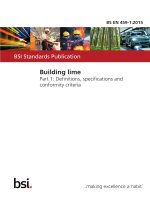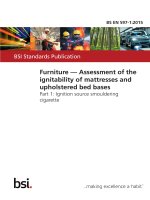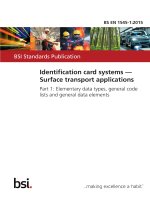Bsi bs en 61290 1 2015
Bạn đang xem bản rút gọn của tài liệu. Xem và tải ngay bản đầy đủ của tài liệu tại đây (1.19 MB, 18 trang )
BS EN 61290-1:2015
BSI Standards Publication
Optical amplifiers — Test
methods
Part 1: Power and gain parameters
BRITISH STANDARD
BS EN 61290-1:2015
National foreword
This British Standard is the UK implementation of EN 61290-1:2015. It is
identical to IEC 61290-1:2014.
The UK participation in its preparation was entrusted by Technical
Committee GEL/86, Fibre optics, to Subcommittee GEL/86/3, Fibre optic
systems and active devices.
A list of organizations represented on this committee can be obtained on
request to its secretary.
This publication does not purport to include all the necessary provisions of
a contract. Users are responsible for its correct application.
© The British Standards Institution 2015.
Published by BSI Standards Limited 2015
ISBN 978 0 580 83420 2
ICS 33.180.30
Compliance with a British Standard cannot confer immunity from
legal obligations.
This British Standard was published under the authority of the
Standards Policy and Strategy Committee on 28 February 2015.
Amendments/corrigenda issued since publication
Date
Text affected
EUROPEAN STANDARD
EN 61290-1
NORME EUROPÉENNE
EUROPÄISCHE NORM
February 2015
ICS 33.180.30
English Version
Optical amplifiers - Test methods Part 1: Power and gain parameters
(IEC 61290-1:2014)
Amplificateurs optiques - Méthodes d'essai Partie 1: Paramètres de puissance et de gain
(IEC 61290-1:2014)
Prüfverfahren für Lichtwellenleiter-Verstärker Teil 1: Optische Leistungs- und Verstärkungsparameter
(IEC 61290-1:2014)
This European Standard was approved by CENELEC on 2015-01-20. CENELEC members are bound to comply with the CEN/CENELEC
Internal Regulations which stipulate the conditions for giving this European Standard the status of a national standard without any alteration.
Up-to-date lists and bibliographical references concerning such national standards may be obtained on application to the CEN-CENELEC
Management Centre or to any CENELEC member.
This European Standard exists in three official versions (English, French, German). A version in any other language made by translation
under the responsibility of a CENELEC member into its own language and notified to the CEN-CENELEC Management Centre has the
same status as the official versions.
CENELEC members are the national electrotechnical committees of Austria, Belgium, Bulgaria, Croatia, Cyprus, the Czech Republic,
Denmark, Estonia, Finland, Former Yugoslav Republic of Macedonia, France, Germany, Greece, Hungary, Iceland, Ireland, Italy, Latvia,
Lithuania, Luxembourg, Malta, the Netherlands, Norway, Poland, Portugal, Romania, Slovakia, Slovenia, Spain, Sweden, Switzerland,
Turkey and the United Kingdom.
European Committee for Electrotechnical Standardization
Comité Européen de Normalisation Electrotechnique
Europäisches Komitee für Elektrotechnische Normung
CEN-CENELEC Management Centre: Avenue Marnix 17, B-1000 Brussels
© 2015 CENELEC All rights of exploitation in any form and by any means reserved worldwide for CENELEC Members.
Ref. No. EN 61290-1:2015 E
BS EN 61290-1:2015
EN 61290-1:2015
-2-
Foreword
The text of document 86C/1188/CDV, future edition 1 of IEC 61290-1, prepared by SC 86C "Fibre
optic systems and active devices" of IEC/TC 86 "Fibre optics" was submitted to the IEC-CENELEC
parallel vote and approved by CENELEC as EN 61290-1:2015.
The following dates are fixed:
•
latest date by which the document has to be implemented at
national level by publication of an identical national
standard or by endorsement
(dop)
2015-10-20
•
latest date by which the national standards conflicting with
the document have to be withdrawn
(dow)
2018-01-20
Attention is drawn to the possibility that some of the elements of this document may be the subject of
patent rights. CENELEC [and/or CEN] shall not be held responsible for identifying any or all such
patent rights.
Endorsement notice
The text of the International Standard IEC 61290-1:2014 was approved by CENELEC as a European
Standard without any modification.
In the official version, for Bibliography, the following notes have to be added for the standards indicated:
IEC 60793-1-1
NOTE
Harmonized as EN 60793-1-1.
IEC 60793-1-40
NOTE
Harmonized as EN 60793-1-40.
IEC 60825-1
NOTE
Harmonized as EN 60825-1.
IEC 60825-2
NOTE
Harmonized as EN 60825-2.
IEC 60874-1
NOTE
Harmonized as EN 60874-1.
IEC 61290-10
NOTE
Harmonized as EN 61290-10 series (not modified).
-3-
BS EN 61290-1:2015
EN 61290-1:2015
Annex ZA
(normative)
Normative references to international publications
with their corresponding European publications
The following documents, in whole or in part, are normatively referenced in this document and are
indispensable for its application. For dated references, only the edition cited applies. For undated
references, the latest edition of the referenced document (including any amendments) applies.
NOTE 1
When an International Publication has been modified by common modifications, indicated by (mod),
the relevant EN/HD applies.
NOTE 2
Up-to-date information on the latest versions of the European Standards listed in this annex is
available here: www.cenelec.eu.
Publication
Year
Title
EN/HD
Year
IEC 61290-1-1
-
Optical amplifiers - Test methods Part 1-1: Power and gain parameters Optical spectrum analyzer method
EN 61290-1-1
-
IEC 61290-1-2
-
Optical amplifiers - Test methods Part 1-2: Power and gain parameters Electrical spectrum analyzer method
EN 61290-1-2
-
IEC 61290-1-3
-
Optical amplifiers - Test methods Part 1-3: Power and gain parameters Optical power meter method
EN 61290-1-3
-
IEC 61291-1
2012
Optical amplifiers Part 1: Generic specification
EN 61291-1
2012
BS EN 61290-1:2015
–2–
IEC 61290-1:2014 IEC 2014
CONTENTS
1
Scope and object ............................................................................................................. 5
2
Normative references ...................................................................................................... 5
3
Acronyms and abbreviations ............................................................................................ 6
4
Optical power and gain test method ................................................................................. 6
5
Optical power and gain parameters ................................................................................. 6
6
Test results ................................................................................................................... 11
Bibliography .......................................................................................................................... 14
Figure 1 – Typical behaviour of the gain as a function of the input signal power ...................... 7
Figure 2 – Typical behaviour of the gain as a function of the wavelength ................................ 7
Figure 3 – Typical behaviour of the gain as a function of the temperature ............................... 8
Figure 4 – Typical behaviour of the gain as a function of the wavelength ................................ 9
Figure 5 – Typical behaviour of the gain fluctuation as a function of time ................................ 9
Figure 6 – Typical behaviour of the output power fluctuation as a function of time ................ 10
Figure 7 – Typical behaviour of the gain as a function of the input signal power .................... 11
Figure 8 – Typical behaviour of the output power as a function of the input signal
power ................................................................................................................................... 11
BS EN 61290-1:2015
IEC 61290-1:2014 IEC 2014
–5–
OPTICAL AMPLIFIERS –
TEST METHODS –
Part 1: Power and gain parameters
1
Scope and object
This part of 61290 applies to all commercially available optical amplifiers (OAs) and optically
amplified subsystems. It applies to OAs using optically pumped fibres (OFAs based on either
rare-earth doped fibres or on the Raman effect), semiconductors (SOAs), and waveguides
(POWAs).
NOTE 1 The applicability of the test methods described in the present standard to distributed Raman amplifiers is
still under study.
The object of this standard is to establish uniform requirements for accurate and reliable
measurements of the following OA parameters, as defined in Clause 3 of IEC 61291-1:2012:
a) nominal output signal power;
b) gain;
c) reverse gain;
d) maximum gain;
e) maximum gain wavelength;
f)
maximum gain variation with temperature;
g) gain wavelength band;
h) gain wavelength variation;
i)
gain stability;
j)
polarization-dependent gain;
k) large-signal output stability;
l)
saturation output power;
m) maximum output signal power;
n) maximum total output power.
NOTE 2 All numerical values followed by (‡).are suggested values for which the measurement is assured. Other
values are acceptable if verified.
The object of this standard is specifically directed to single-channel amplifiers. For
multichannel amplifiers, one should refer to the IEC 61290-10 series.
2
Normative references
The following documents, in whole or in part, are normatively referenced in this document and
are indispensable for its application. For dated references, only the edition cited applies. For
undated references, the latest edition of the referenced document (including any
amendments) applies.
IEC 61290-1-1, Optical amplifiers – Test methods – Part 1-1: Power and gain parameters –
Optical spectrum analyzer method
IEC 61290-1-2, Optical amplifiers – Test methods – Part 1-2: Power and gain parameters –
Electrical spectrum analyzer method
BS EN 61290-1:2015
–6–
IEC 61290-1:2014 IEC 2014
IEC 61290-1-3, Optical amplifiers – Test methods – Part 1-3: Power and gain parameters –
Optical power meter method
IEC 61291-1:2012, Optical amplifiers – Part 1: Generic specification
3
Acronyms and abbreviations
ASE
amplified spontaneous emission
OA
optical amplifier
OFA
optical fibre amplifier
SOA
semiconductor optical amplifier
FWHM
full width at half maximum
OSA
optical spectrum analyzer
4
Optical power and gain test method
Three commonly practised procedures for quantifying the optical power and gain of an OA are
considered in this standard.
The aim of the first procedure (see IEC 61290-1-1) is to determine the optical power and gain
by means of the optical spectrum analyzer test method.
The aim of the second procedure (see IEC 61290-1-2) is to determine the optical power and
gain by means of an optical detector and an electrical spectrum analyzer.
The aim of the third procedure (see IEC 61290-1-3) is to determine the optical power and gain
by means of an optical power meter and an optical bandpass filter.
5
Optical power and gain parameters
The parameters listed below are required for gain and power:
a) Nominal output signal power: The nominal output signal power is given by the minimum
output signal optical power, for an input signal optical power specified in the relevant
detail specification, and under nominal operating conditions, given in the relevant detail
specification. To find this minimum value, input and output signal power levels shall be
continuously monitored for a given duration of time and in presence of changes in the
state of polarization and other instabilities, as specified in the relevant detail specification.
The measurement procedures and calculations are described in each test method.
b) Gain: The measurement procedures and calculations are described in each test method.
c) Reverse gain: As in b), but with the OA operating with the input port used as output port
and vice-versa.
d) Maximum gain: As in b), but use a wavelength-tuneable optical source, repeat all
procedures at different wavelengths in a way to cover the wavelength range specified in
the relevant detail specification.
Unless otherwise specified, the wavelength should be changed by steps smaller than 1 nm
(‡) around the wavelength where the ASE spectral profile, observed (e.g. with an optical
spectrum analyzer or a monochromator) without the input signal, takes its maximum value.
NOTE 1 A wavelength measurement accuracy of ±0,01 nm, within the operating wavelength range of the OA,
is attainable with commercially available wavelength meters based on interference-fringes counting techniques.
Some tuneable external-cavity laser-diode instruments provide a wavelength measurement accuracy of
±0,2 nm.
The gain values are measured at the different wavelengths as described in b) above. The
maximum gain shall be given by the highest of all these gain values at nominal operating
BS EN 61290-1:2015
IEC 61290-1:2014 IEC 2014
–7–
Signal gain (dB)
condition. Figure 1 shows the typical behaviour of the gain as a function of the input signal
power.
Small-signal gain
Linear region
Input signal power
(dBm)
IEC
Figure 1 – Typical behaviour of the gain as a function of the input signal power
Signal gain (dB)
e) Maximum gain wavelength: As in d) above, the maximum gain wavelength shall be the
wavelength at which the maximum gain occurs. Refer to Figure 2 for typical gain
behaviour for different wavelengths.
Maximum gain
N dB
Gain wavelength band
Maximum gain wavelength
Signal wavelength (nm)
IEC
Figure 2 – Typical behaviour of the gain as a function of the wavelength
f)
Maximum gain variation with temperature: The maximum change of signal gain for a
certain specified temperature range. The measurement procedures and calculations are
described below shall be followed, with reference to the measurement set-up and
procedure for each test method:
1) As described in b), measure the maximum gain G max-Tmp within the variation of
temperature, as specified in the relevant detail specification.
2) As described in b), measure the minimum gain G min-Tmp within the variation of
temperature, as specified in the relevant detail specification.
3) Maximum gain variation with temperature ∆G tmp is given by the following formula:
∆G tmp = G max-tmp – G min-tmp (dB)
[1]
Refer to Figure 3.
Gain variation with temperature may depend on the signal wavelength owing to its
active fibre characteristics. The wavelength at which the parameter is specified and
measured should be stated.
BS EN 61290-1:2015
Signal gain (dB)
–8–
IEC 61290-1:2014 IEC 2014
Gmax-tmp
∆Gtmp
Gain variation with
temperature
Gmin-tmp
Specified temperature range
Tmax
Tmin
Temperature (°C)
IEC
Figure 3 – Typical behaviour of the gain as a function of the temperature
g) Gain wavelength band: Measure the maximum gain as described in d). Identify those
wavelengths at which the gain is N dB below the maximum gain. The gain wavelength
band shall be given by the wavelength interval(s) comprised between those wavelengths
within which the gain is comprised between the maximum gain value and a value N dB
below the maximum gain. Calculations are processed according to the following procedure.
1) Plot the gain of each wavelength to the gains of adjacent wavelengths as shown in
Figure 2.
2) Draw a horizontal line N -dB down from the maximum gain point.
3) The two or more intersection points define the gain wavelength band. The minimum
difference in N -dB down wavelengths is gain wavelength band.
NOTE 2
A value of N = 3 is typically applied.
h) Gain wavelength variation: Measure the maximum gain and minimum gain over the
specified measurement wavelength range as described in d). The gain variation shall be
the difference between the maximum and the minimum gain values. Calculations are
processed according to the following procedure.
1) Plot the gain of each wavelength as shown in Figure 4.
2) Find the maximum gain, G max-l (dB) within wavelength band.
3) Find the minimum gain, G min-l (dB) within wavelength band.
4) Calculate the gain wavelength variation, ∆G l (dB) by the following formula:
∆G l = G max-l – G min-l (dB)
[2]
BS EN 61290-1:2015
Signal gain (dB)
IEC 61290-1:2014 IEC 2014
–9–
Gmax-l
∆Gl
Gain
wavelength
variation
Gmin-l
Wavelength band
lmax
Signal wavelength (nm)
lmin
IEC
Figure 4 – Typical behaviour of the gain as a function of the wavelength
i)
Gain stability: The maximum degree of gain fluctuation of the maximum and minimum
signal gain, for a certain specified test period, as specified in the relevant detail
specification. The measurement procedure and calculations described below shall be
followed with reference to the measurement set-up for each test method. Refer to Figure 5
for typical behaviour of the gain fluctuation.
1) As for b), measure the maximum gain G max-stability for a certain specified test period,
as specified in the relevant detail specification.
2) As for b), measure the minimum gain G min-stability for a certain specified test period, as
specified in the relevant detail specification.
3) Gain stability ∆G stability (dB) is given by the following formula:
Signal gain (dB)
∆G stability = G max-stability – G min-stability (dB)
[3]
Gmax-stability
∆Gstability
Gain
stability
Gmin-stability
Test Period
Tstart
Tend
Time (s or min)
IEC
Figure 5 – Typical behaviour of the gain fluctuation as a function of time
j)
Polarization-dependent gain: Gain values at the different states of polarization as
described in b). Procedure and calculations are described in each test method.
k) Large-signal output stability: The maximum degree of gain fluctuation of the maximum and
minimum output optical power, for a certain specified test period, as specified in the
relevant detail specification. The measurement procedure and calculations described
BS EN 61290-1:2015
– 10 –
IEC 61290-1:2014 IEC 2014
below shall be followed, with reference to the measurement set-up for each test method.
Refer to Figure 6 for typical behaviour of the output power fluctuation.
1) As described in a) above, measure the maximum output signal power
P max-stability for a certain specified test period, at a given wavelength and maximum
signal input power, as specified in the relevant detail specification.
2) As described in a) above, measure the minimum output signal power
P min-stability for a certain specified test period, at a given wavelength and maximum
signal input power, as specified in the relevant detail specification.
3) Compare P max-stability with P min-stability , and subtract P min-stability from P max-stability to
obtain large signal output stability.
4) Large-signal output stability ∆P stability (dB) is given by the following formula:
Output power (dBm)
∆P stability = P max-stability – P min-stability (dB)
[4]
Pmax-stability
∆Pstability
Power
stability
Pmin-stability
Test period
Tstart
Tend
Time (s or min)
IEC
Figure 6 – Typical behaviour of the output power fluctuation as a function of time
l)
Saturation output power: The measurement procedure described below shall be followed
with reference to the measurement set-up for each test method. The saturation output
power above which the gain is reduced by N dB (typically N = 3) with respect to the smallsignal gain at the signal wavelength. Calculations are processed according to the
following procedure.
1) Plot gain vs. input power as described in d). Refer to Figure 7 for typical behaviour of
the gain.
2) Plot the output power vs. input power. Refer to Figure 8 for typical behaviour of the
output power.
3) Find the gain G sat (dB) which is N-dB smaller than small signal gain under linear gain
region.
4) Find the input power P in-sat (dBm) which produce the gain G sat .
5) Find the output power P out-sat (dBm) at the input power P in-sat .
6) P out-sat gives the saturation output power.
NOTE 3
A value of N = 3 is typically applied.
BS EN 61290-1:2015
Signal gain (dB)
IEC 61290-1:2014 IEC 2014
– 11 –
Gmax
N dB
Gsat
Linear region
Pin-sat
Input power
(dBm)
IEC
Output signal power (dBm)
Figure 7 – Typical behaviour of the gain as a function of the input signal power
Pout-sat
Pin-sat
Input power
(dBm)
IEC
Figure 8 – Typical behaviour of the output power as a function of the input signal power
m) Maximum output signal power: The measurement procedure and calculations are
described in each test method.
n) Maximum total output power: The measurement procedure and calculations are described
in each test method.
6
Test results
Test results are as follows:
a) Nominal optical signal power:
The following details shall be presented:
BS EN 61290-1:2015
– 12 –
IEC 61290-1:2014 IEC 2014
1)
arrangement of the test set-up;
2)
spectral linewidth (FWHM) of the optical source;
3)
indication of the optical pump power and possibly driving current of pump lasers for
OFAs, and injection current for SOAs (if applicable);
4)
operating temperature (if required);
5)
6)
input signal optical power, P in ;
time-averaged input signal power (if applicable);
7)
resolution bandwidth of the optical spectrum analyzer (if applicable);
8)
resolution bandwidth of the electrical spectrum analyzer (if applicable);
9)
FWHM of the optical bandpass filter (if applicable);
10) central wavelength of the optical bandpass filter (if applicable);
11) wavelength of the measurement;
12) nominal optical signal power levels, P;
13) change in the state of polarization given to the input signal light.
b) Gain: Details 1) to 11), previously listed for nominal optical signal power levels, shall be
presented and, in addition:
12)
gain
Parameters 5) and 12) may be replaced with the gain versus input optical signal power
curve.
c) Reverse gain: Details 1) to 11), previously listed for gain, shall be presented and, in
addition:
12)
reverse gain
Parameters 5) and 12) may be replaced with the reverse gain versus input optical signal
power curve.
d) Maximum gain: Details 1) to 11), previously listed for gain, shall be presented and, in
addition:
12)
wavelength range of the measurement;
13)
maximum gain.
Parameters 5) and 13) may be replaced with the maximum gain versus input optical signal
power curve.
e) Maximum gain wavelength: Details 1) to 11), previously listed for gain, shall be presented
and, in addition:
12)
wavelength range of the measurement;
13)
wavelength measurement accuracy;
14)
maximum gain wavelength.
Parameters 12) and 14) may be replaced with the gain versus input signal wavelength
curve.
f)
Maximum gain variation with temperature: Details 1) to 11), previously listed for gain, shall
be presented and, in addition:
12)
13)
the maximum and minimum gain with temperature, G max-tmp and G min-tmp
maximum gain variation with temperature
g) Gain wavelength band: Details 1) to 11), previously listed for gain, shall be presented and,
in addition:
12)
wavelength range of the measurement;
13)
wavelength measurement accuracy;
14)
gain wavelength band;
BS EN 61290-1:2015
IEC 61290-1:2014 IEC 2014
15)
– 13 –
the N value chosen for the determination of the wavelength bandwidth.
Parameters 12) and 14) and 15) may be replaced with the gain versus input signal
wavelength curve.
h) Gain wavelength variation: Details 1) to 11), previously listed for gain, shall be presented
and, in addition:
12)
wavelength range of the measurement;
13)
wavelength measurement accuracy of the optical spectrum analyzer;
14)
gain variation.
Parameters 12) and 14) may be replaced with the gain versus input signal wavelength
curve.
i)
j)
Gain stability: Details 1) to 11), previously listed for gain, shall be presented and, in
addition:
12)
the maximum and minimum gain, G max-stability and G min-stability ;
13)
gain stability.
Polarization-dependent gain: Details 1) to 11), previously listed for gain, shall be
presented and, in addition:
12)
polarization dependency of the apparatus for detecting optical power for each test
method;
13)
14)
the maximum and minimum gain, G max-pol and G min-pol ;
polarization-dependent gain;
15)
change in the state of polarization given to the input signal light.
k) Large-signal output stability: Details 1) to 11), previously listed for gain, shall be
presented and, in addition:
12)
13)
l)
the maximum and minimum output power P max-stability and P min-stability ;
large-signal output stability.
Saturation output power: Details 1) to 11), previously listed for gain, shall be presented
and, in addition:
12)
saturation figure N;
13)
saturation gain G sat ;
14)
saturation input power P in-sat ;
saturation output power P out-sat.
m) Maximum output signal power: Details 1) to 11), previously listed for gain, shall be
presented and, in addition:
15)
maximum output signal power P sig-out-max.
n) Maximum total output power: Details 1) to 11), previously listed for gain, shall be
presented and, in addition:
12)
12)
maximum total output power P out-max.
BS EN 61290-1:2015
– 14 –
IEC 61290-1:2014 IEC 2014
Bibliography
IEC 60793-1-1, Optical fibres – Part 1-1: Measurement methods and test procedures –
General and guidance
IEC 60793-1-40, Optical fibres – Part 1-40: Measurement methods and test procedures –
Attenuation
IEC 60825-1, Safety of laser products – Part 1: Equipment classification and requirements
IEC 60825-2, Safety of laser products – Part 2: Safety of optical fibre communication systems
(OFCS)
IEC 60874-1, Fibre optic interconnecting devices and passive components – Connectors for
optical fibres and cables – Part 1: Generic specification
IEC 61290 (all parts 10), Optical amplifiers – Test methods – Part 10: Multichannel
parameters
IEC TR 61931, Fibre optic – Terminology
_____________
This page deliberately left blank
NO COPYING WITHOUT BSI PERMISSION EXCEPT AS PERMITTED BY COPYRIGHT LAW
British Standards Institution (BSI)
BSI is the national body responsible for preparing British Standards and other
standards-related publications, information and services.
BSI is incorporated by Royal Charter. British Standards and other standardization
products are published by BSI Standards Limited.
About us
Revisions
We bring together business, industry, government, consumers, innovators
and others to shape their combined experience and expertise into standards
-based solutions.
Our British Standards and other publications are updated by amendment or revision.
The knowledge embodied in our standards has been carefully assembled in
a dependable format and refined through our open consultation process.
Organizations of all sizes and across all sectors choose standards to help
them achieve their goals.
Information on standards
We can provide you with the knowledge that your organization needs
to succeed. Find out more about British Standards by visiting our website at
bsigroup.com/standards or contacting our Customer Services team or
Knowledge Centre.
Buying standards
You can buy and download PDF versions of BSI publications, including British
and adopted European and international standards, through our website at
bsigroup.com/shop, where hard copies can also be purchased.
If you need international and foreign standards from other Standards Development
Organizations, hard copies can be ordered from our Customer Services team.
Subscriptions
Our range of subscription services are designed to make using standards
easier for you. For further information on our subscription products go to
bsigroup.com/subscriptions.
With British Standards Online (BSOL) you’ll have instant access to over 55,000
British and adopted European and international standards from your desktop.
It’s available 24/7 and is refreshed daily so you’ll always be up to date.
You can keep in touch with standards developments and receive substantial
discounts on the purchase price of standards, both in single copy and subscription
format, by becoming a BSI Subscribing Member.
PLUS is an updating service exclusive to BSI Subscribing Members. You will
automatically receive the latest hard copy of your standards when they’re
revised or replaced.
To find out more about becoming a BSI Subscribing Member and the benefits
of membership, please visit bsigroup.com/shop.
With a Multi-User Network Licence (MUNL) you are able to host standards
publications on your intranet. Licences can cover as few or as many users as you
wish. With updates supplied as soon as they’re available, you can be sure your
documentation is current. For further information, email
BSI Group Headquarters
389 Chiswick High Road London W4 4AL UK
We continually improve the quality of our products and services to benefit your
business. If you find an inaccuracy or ambiguity within a British Standard or other
BSI publication please inform the Knowledge Centre.
Copyright
All the data, software and documentation set out in all British Standards and
other BSI publications are the property of and copyrighted by BSI, or some person
or entity that owns copyright in the information used (such as the international
standardization bodies) and has formally licensed such information to BSI for
commercial publication and use. Except as permitted under the Copyright, Designs
and Patents Act 1988 no extract may be reproduced, stored in a retrieval system
or transmitted in any form or by any means – electronic, photocopying, recording
or otherwise – without prior written permission from BSI. Details and advice can
be obtained from the Copyright & Licensing Department.
Useful Contacts:
Customer Services
Tel: +44 845 086 9001
Email (orders):
Email (enquiries):
Subscriptions
Tel: +44 845 086 9001
Email:
Knowledge Centre
Tel: +44 20 8996 7004
Email:
Copyright & Licensing
Tel: +44 20 8996 7070
Email:









